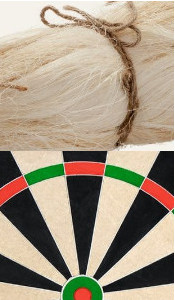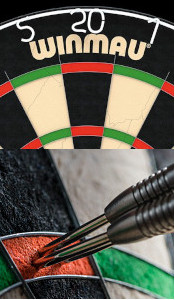Dartboard Selection and Care
John Roufas2023-10-03T09:49:29-04:00Dartboard Selection and Care
The Right Board for You
Whether you are playing in a tournament or your garage, choose a quality-made board. Good boards will be made of compressed sisal, a dried grass from Africa, which which heals as you remove your dart and will last longer and perform better than other materials.
Along with sisal, look for a board with with steel wiring on the face. A more expensive board will have a blade wire system as opposed to a round wire that is stapled into the board. While you can save some money by buying the less expensive round wire, over time, you might have fewer bound outs off the wire and have less trouble with bent wires in the dartboard face.
A quality steel number ring which can be removed from the board and replaced when rotating the board is also essential to make sure you are creating an even wear.


Taking Care of your Board
Dartboards should be rotated regularly to ensure even wear across the entire surface of the board. As you improve, certain numbers will receive more interest than others and naturally wear quicker. Removing the number ring and rotating the board two segments counter-clockwise will mean that wear is spread out. This will not, however, spare the bull. If you find that practice is causing a lot of wear on the bull, you might consider a set of Winmau Practice Rings, which can be hung on a lesser used segment.
Bristle boards, being manufactured from sisal, a natural fibre, are susceptible to moisture damage. Under no circumstances should any moisture be placed onto the board. There is an “old wives tale” that you can revive a dartboard by spraying the board with water. This is false, it will cause the sisal fibres to swell and destroy the board.
A key element in maintaining your dartboard is maintaining the points of your darts. Ensure points are kept free of burrs and are not hooked. A dart with a hook will damage a bristle board quickly as it will pull the sisal out as you remove the dart. Similarly, some new points with etching may make them stay in the boards are really rough on boards as they are removed. Try twisting the dart as you pull it from the board, as it will cause less wear.



